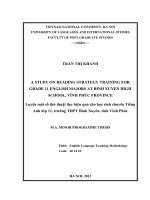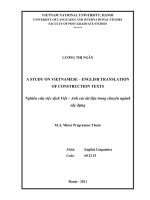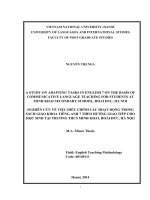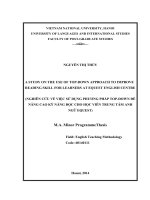A study on specialized terminologies translation for Information Technology
Bạn đang xem bản rút gọn của tài liệu. Xem và tải ngay bản đầy đủ của tài liệu tại đây (910.74 KB, 55 trang )
BỘ GIÁO DỤC VÀ ĐÀO TẠO
TRƯỜNG ĐẠI HỌC DÂN LẬP HẢI PHÒNG
-------------------------------
ISO 9001 :2008
KHÓA LUẬN TỐT NGHIỆP
NGÀNH: NGÔN NGỮ ANH
Sinh viên
: Đặng Quang Huy
Lớp
: NA1804
Giảng viên hướng dẫn : Ths. Đặng Thị Vân
HẢI PHÒNG - 2018
MINISTRY OF EDUCATION AND TRAINING
HAIPHONG PRIVATE UNIVERSITY
-----------------------------------
A STUDY ON SPECIALIZED TERMINOLOGIES
TRANSLATION FOR INFORMATION
TECHNOLOGY
GRADUATION PAPER
Student
: Dang Quang Huy
Class
: NA1804
Supervisor
: Dang Thi Van, M.A
HẢI PHÒNG – 2018
NHIỆM VỤ ĐỀ TÀI TỐT NGHIỆP
1. Nội dung và các yêu cầu cần giải quyết trong nhiệm vụ đề tài tốt nghiệp
( về lý luận, thực tiễn, các số liệu cần tính toán và các bản vẽ).
............................................................................
............................................................................
...........................................................................
...........................................................................
...........................................................................
...........................................................................
2. Các số liệu cần thiết để tính toán:
..........................................................................
..........................................................................
..........................................................................
..........................................................................
..........................................................................
CÁN BỘ HƯỚNG DẪN ĐỀ TÀI TỐT NGHIỆP
Người hướng dẫn thứ nhất:
Họ và tên: Đặng Thị Vân
Học hàm, học vị: Thạc sĩ
Cơ quan công tác: Trường Đại học Dân lập Hải Phòng
Nội dung hướng dẫn: A study on specialized terminologies translation for
Information Technology
Người hướng dẫn thứ hai:
Họ và tên:.............................................................................................
Học hàm, học vị:...................................................................................
Cơ quan công tác:.................................................................................
Nội dung hướng dẫn:............................................................................
Đề tài tốt nghiệp được giao ngày 12 tháng 3 năm 2018
Yêu cầu phải hoàn thành xong trước ngày 31 tháng 5 năm 2018
Đã nhận nhiệm vụ ĐTTN
Đã giao nhiệm vụ ĐTTN
Sinh viên
Người hướng dẫn
Hải Phòng, ngày
tháng
năm 2018
Hiệu trưởng
GS.TS.NGƯT Trần Hữu Nghị
PHẦN NHẬN XÉT CỦA CÁN BỘ HƯỚNG DẪN
1. Tinh thần thái độ của sinh viên trong quá trình làm đề tài tốt
nghiệp:
……………………………………………………………………………..
……………………………………………………………………………..
……………………………………………………………………………..
……………………………………………………………………………..
……………………………………………………………………………..
2. Đánh giá chất lượng của khóa luận (so với nội dung yêu cầu đã đề ra
trong nhiệm vụ Đ.T. T.N trên các mặt lý luận, thực tiễn, tính toán số
liệu…):
……………………………………………………………………………..
……………………………………………………………………………..
……………………………………………………………………………..
……………………………………………………………………………..
……………………………………………………………………………..
3. Cho điểm của cán bộ hướng dẫn (ghi bằng cả số và chữ):
……………………………………………………………………………..
……………………………………………………………………………..
Hải Phòng, ngày … tháng … năm 2018
Cán bộ hướng dẫn
(Ký và ghi rõ họ tên)
NHẬN XÉT ĐÁNH GIÁ
CỦA NGƯỜI CHẤM PHẢN BIỆN ĐỀ TÀI TỐT NGHIỆP
1. Đánh giá chất lượng đề tài tốt nghiệp về các mặt thu thập và phân
tích tài liệu, số liệu ban đầu, giá trị lí luận và thực tiễn của đề tài.
..........................................................................................................................
..........................................................................................................................
..........................................................................................................................
..........................................................................................................................
..........................................................................................................................
2. Cho điểm của người chấm phản biện : ………………………..
(Điểm ghi bằng số và chữ)
Ngày.......... tháng......... năm 2018
Người chấm phản biện
ACKNOWLEDGEMENTS
In the process of completing this graduation paper, I have received a great
deal of help, guidance and encouragement from my teachers and friends.
First and foremost, I would like to express my sincere gratitude towards my
supervisor, Ms Dang Thi Van, M.A for helping me through this challenging
process.
Secondly, I also want to thank all teachers of Foreign Languages Department
of Hai Phong Private University for their supportive lectures during my fouryear study that have given me many wonderful insights as well as background
knowledge to help fulfill this study.
Last but not least, I would like to thank my family; my friends who have
offered continuous support, encouragement that help me complete this paper.
Hai Phong, June 2018
TABLE OF CONTENTS
PART I: INTRODUCTION ......................................................................... 1
I.1. Rationale ................................................................................................... 1
I.2. Aim of the study:....................................................................................... 1
I.3.Scope of the study: ..................................................................................... 2
I.4. Method of the study: ................................................................................. 2
I.5. Design of the study: .................................................................................. 2
PART II: DEVELOPMENT......................................................................... 4
CHAPTER I: THEORETICAL BACKGROUND ..................................... 4
I.1.TRANSLATION THEORY:...................................................................... 4
I.1.1. Definition of translation: ........................................................................ 4
I.1.2. Translation methods: .............................................................................. 5
I.1.2.1. Word for word translation: .................................................................. 5
I.1.2.2. Literal translation: ............................................................................... 5
I.1.2.3. Faithful translation: ............................................................................. 5
I.1.2.4. Semantic translation: ........................................................................... 6
I.1.2.5.Adaptation: ........................................................................................... 6
I.1.2.6. Free translation: ................................................................................... 6
I.1.2.7. Idiomatic translation: .......................................................................... 6
I.1.2.8. Communicative translation: ................................................................ 6
I.1.3.Equivalence in translation: ...................................................................... 7
I.2. English for special purpose ....................................................................... 8
I.2.1. Definition of ESP: .................................................................................. 8
I.2.2. Types of ESP ........................................................................................ 11
I.2.3. Definition of technical translation ........................................................ 13
I.3. Terminology:........................................................................................... 14
I.3.1. Definition: ............................................................................................ 14
I.3.2. General features of Terminology: ........................................................ 14
I.3.2.1. Accurateness: .................................................................................... 14
I.3.2.2. Systematism: ..................................................................................... 15
I.3.2.3. Internationalism: ............................................................................... 16
I.3.2.4. Nationalism: ...................................................................................... 16
I.3.2.5. Popularity: ......................................................................................... 17
I.3.3.The creation of Terminology:................................................................ 17
I.3.4. the distinction between terms and words:............................................. 18
CHAPTER II: AN INVESTIGATION INTO ENGLISH –
VIETNAMESE TRANSLATION OF IT TERMS AND THEIR
VIETNAMESE EQUIVALENCE .............................................................. 19
II.1. Definition of Information technology: ................................................... 19
II.2. Language in Information Technology:................................................... 19
II.3.The popular construction of IT terms...................................................... 20
II.3.1. Single terms: ....................................................................................... 20
II.3.2. Compound terms: ................................................................................ 27
II.3.3. Common IT abbreviations: ................................................................. 30
CHAPTER III: TECHNIQUES APPLIED IN THE TRANSLATION OF
INFORMATION TECHNOLOGY TERMINOLOGIES ........................ 32
III.1. Shift or transposition translation:.......................................................... 32
III.2. Translation by paraphrase using unrelated words: ................................ 34
III.3.Translation of abbreviation by using loan words plus explanation: ....... 35
CHAPTER IV: DIFFICULTIES IN TRANSLATING IT TERMS
FACED BY VIETNAMESE STUDENTS AND SUGGESTED
SOLUTIONS................................................................................................ 37
IV.1.Difficulties: ........................................................................................... 37
IV.2.Suggested solutions: .............................................................................. 38
PART III: CONCLUSION ......................................................................... 39
1. Limitations of the study: ............................................................................ 39
2. Suggestions for further study:.................................................................... 39
REFERENCES ............................................................................................ 40
Appendix I (Vocabulary) ............................................................................ 42
Appendix 2( Exercise) ................................................................................. 43
APPENDIX 3 (Translation sample) ........................................................... 44
ABBREVIATIONS
IT
Information technology
SL
Source language
TL
Target language
ESP
English for special purpose
EAP
English for academic purpose
EOP
English for occupational purpose
PART I: INTRODUCTION
I.1. Rationale
Information technology plays an undeniably vital part in our nowadays
society as it has a great impact on every aspects of life and especially on the
development of a country. As a developing country, Vietnam is trying to
keep up with other nations in many aspects including Information
technology. However, this is an absolutely large field with a thousand of
specific terminologies that require learners a deep knowledge and constant
researches. As a result, translation of IT terminologies may cause some
difficulties for leaners when translating from SL to TL.
A number of Vietnamese learners get trouble in translating IT terms. I
myself often become confused when coping with terms regarding this field.
Hence, it is very necessary for me as well as learners to acquire certain
accumulation of linguistic and cultural knowledge in both native language
and foreign languages. Moreover, I am also interested in translation skills,
especially in translation of IT terms. That is the main reason inspiring me to
carry out this research. More importantly, studying this theme offers me a
chance to have thorough understanding about technical translations.
I.2. Aim of the study:
The study on specialized terminologies translation for Information
technology aims at figuring out an overview on translation strategies and
procedures that are often applied as well as finding commonly used
terminologies in Information technology field.
In details, my Graduation paper aims at:
Collecting and presenting basic English terminologies in IT.
Providing their Vietnamese equivalents or expressions.
Preliminarily analyzing translation strategies and procedures employed
in the translation of these English terms into Vietnamese.
1
Hopefully, this study can provide readers with overall comprehension
about the information from written text and from visual forms of
presentation related to Information technology terms, help them translate it
effectively.
I.3.Scope of the study:
The terms used in IT field would require a great amount of effort and time
to study. Due to limitation of time and knowledge, mistakes and
shortcomings are unavoidable. Therefore, the study only focused on some
basic translating strategies and contrastive analysis between English and
Vietnamese IT terms.
I.4. Method of the study:
This Graduation paper is carried out by using the qualitative method, which
approaches research concepts and methods from the academic field to
provide insights into the problem and help develop ideas
All of the English – Vietnamese terms used in this study are collected from
dictionaries and the internet, which give illustrations to help readers have
better understanding about Information Technology field
I.5. Design of the study:
The study is divided into three parts:
Part I is the Introduction in which rationale, aim of the study, method
of the study and design of the study are presented.
Part II is the Development that includes four chapters:
o
Chapter I is an overview of theoretical background which includes
the definition, methods, procedures of translation in general and ESP
translation, and definition of term.
o
Chapter II is an investigation into English-Vietnamese translation of
IT terms and their Vietnamese equivalents which aims at finding the
popular construction of IT terminologies as well as some commonly
used ones.
2
o
Chapter III focuses on some techniques applied in the translation of
IT terminologies.
o
Chapter IV finds out some difficulties faced by students when coping
with IT terminologies.
Part III is Conclusion that indicates strengths and weaknesses of the
study as well as some suggestions for further research.
3
PART II: DEVELOPMENT
CHAPTER I: THEORETICAL BACKGROUND
I.1.TRANSLATION THEORY:
I.1.1. Definition of translation:
The definition of translation varies upon linguists all around the world.
There are some typical concepts as follow:
Translation can be defined as the result of a linguistic –textual
operation in which a text in one language is re-contextualized in
another language. As a linguistic-textual operation, translation is,
however, subject to, and substantially influenced by, a variety of
extra-linguistic factors and conditions. It is this interaction between
‘ inner’ linguistic-textual and ‘outer’ extra-linguistic, contextual
factors that makes translation such a complex phenomenon
(House.J,2015).
Translation is the replacement of the textual material in one
language (SL) by equivalent textual material in another language
(TL) (Catford,1965).
Translation is made possible by an equivalent of thought that lies
behind its different verbal expressions (Savory, 1968).
Translation is to be understood as the process whereby a message
expressed in a specific source language is linguistically transformed
in order to be understood by readers of the target language
(Houbert,1998).
Translation is the transformation of a text originally in one language
into an equivalent in the content of the message and the formal
features and the roles of the original (Bell,1991).
Translation is the interpretation of the meaning of a text in one
language (the source text) and the production, in another language
4
of an equivalent text (the target text) that communicates the same
message (Nida,E.A,1959).
I.1.2. Translation methods:
There is no standard or only one guaranteed method for translation.
People have different methods regarding translation strategy and it all
depends on some factors such as the purpose of the translation, the nature
of readership and the text types.
According to Newmark, P (1988:45) there are eight methods of
translation namely word-for-word translation, literal translation, faithful
translation, semantic translation, adaptation, free translation, idiomatic
translation and communicative translation.
I.1.2.1. Word for word translation:
The method of translation in which the SL (Source language) word
order is preserved and the words translated singly by their most common
meanings. Cultural words are translated literally. The main use of this
method is either to understand the mechanics of the source language or to
construe a difficult text as pre -translation process.
I.1.2.2. Literal translation:
This is a broader form of translation, each SL word has a
corresponding TL word, but their primary meaning may differ. The SL
grammatical forms are converted to their nearest target language
equivalents. However, the lexical words are again translated out of
context. Literal translation is considered the basic translation step, both in
communication and semantic translation, in that translation starts from
there. As pre-translation process, it indicates problems to be solved.
I.1.2.3. Faithful translation:
A faithful translation attempts to reproduce the precise contextual
meaning of the original within the constraints of the TL grammatical
structures. It “transfers” cultural words and preserves the degree of
grammatical and lexical “abnormality” (deviation from SL norms) in the
5
translation. It attempts to be completely faithful to the intentions and the
text-realization of the SL writer.
I.1.2.4. Semantic translation:
Semantic translation differs from faithful translation only in as far as it
must take more account of the aesthetic value of the SL text,
compromising on “meaning” where appropriate so that no assonance, word
play or repetition jars in finished version.
I.1.2.5.Adaptation:
This method is the freest form of translation. It is frequently used for
plays (comedies) and poetry: themes, characters, plots preserved, SL
culture converted to TL culture and text is rewritten. The deplorable
practice of having a play or poem literally translated and then rewritten by
an established dramatist or poet has produced many poor adaptations, but
other adaptations have ‘rescued’ period plays.
I.1.2.6. Free translation:
Free translation is the translation which is not close to the original, but
the translation just transmits meanings of the SL in her/ his own words. It
reproduces the matter without the manner, or the content without the form
of the original. Usually it is a paraphrase much longer than the original.
Therefore, the advantage is that the text in TL sounds more natural. On the
contrary, the disadvantage is that translating is too casual to understand the
original because of its freedom.
I.1.2.7. Idiomatic translation:
Idiomatic translation is used for colloquialism and idioms whose
literalism is the translation, by which the translator does not transfer the
literalism of the original, uses the translation of colloquialisms and idioms.
I.1.2.8. Communicative translation:
It attempts to render the exact contextual meaning of the original in
such a way that both language and content are readily acceptable and
comprehensible to readership. “… But even here the translation still has to
6
respect and work on the form of the source language text as the only
material basic for his work” ( Newmark,P ,1982:38).
I.1.3.Equivalence in translation:
Baker, M (In other word, 1992) explores the notion of equivalence
at different levels, in relation to the translation process, including all
different aspects of translation and hence putting together the linguistic
and the communicative approach. She distinguishes:
Equivalence that can appear at word level and above word level
When translating from one language into another. Baker acknowledges
that, in a bottom up approach to translation, equivalence at word level is
the first element to be taken into consideration by the translator. In fact,
when the translator starts analyzing the ST she looks at the words as single
units in order to find a direct 'equivalent' term in the TL. Baker gives a
definition of the term word since it should be remembered that a single
word can sometimes be assigned different meanings in different languages
and might be regarded as being a more complex unit or morpheme. This
means that the translator should pay attention to a number of factors when
considering a single word, such as number, gender and tense.
Grammatical equivalence
When referring to the diversity of grammatical categories across
languages. She notes that grammatical rules may vary across languages
and this may pose some problems in terms of finding a direct
correspondence in the TL. In fact, she claims that different grammatical
structures in the SL and TL may cause remarkable changes in the way the
information or message is carried across. These changes may induce the
translator either to add or to omit information in the TT because of the lack
of particular grammatical devices in the TL itself. Amongst these
grammatical devices which might cause problems in translation Baker
focuses on number, tense and aspects, voice, person and gender.
7
Textual equivalence
When referring to the equivalence between a SL text and a TL text in
terms of information and cohesion. Texture is a very important feature in
translation since it provides useful guidelines for the comprehension and
analysis of the ST which can help the translator in his or her attempt to
produce a cohesive and coherent text for the TL audience in a specific
context. It is up to the translator to decide whether or not to maintain the
cohesive ties as well as the coherence of the SL text. His or her decision
will be guided by three main factors, that is, the target audience, the
purpose of the translation and the text type.
Pragmatic equivalence
When referring to implicatures and strategies of avoidance during the
translation process. Implicature is not about what is explicitly said but
what is implied. Therefore, the translator needs to work out implied
meanings in translation in order to get the ST message across. The role of
the translator is to recreate the author's intention in another culture in such
a way that enables the TC reader to understand it clearly.
I.2. English for special purpose
I.2.1. Definition of ESP:
Strevens (1988: 1) says that “ESP is a particular case of the general
category of special purpose language teaching”. Defining ESP is a very
difficult task and gains a lot of attention of many researchers. That is
because different researchers have given different emphases to the variety
of elements that characterize ESP.
According to Strevens (1988: 1-2), a definition of ESP needs to distinguish
between four absolute and two variable characteristics:
Absolute characteristics of ESP :
ESP consists of English language teaching which is:
1. Designed to meet specific needs of the learners.
8
2. Related in content (i.e., in its themes and topics) to particular
disciplines, occupations and activities.
3. Centered on the language appropriate to those activities, in syntax,
lexis, discourse, semantics, etc.
Variable characteristics of ESP:
ESP may be, but is not necessarily:
1. Restricted as to the language skills to be learnt (e.g.: reading only,
speech recognition only, etc.).
2. Taught according to any pre-ordained methodology (i.e., ESP is not
restricted to any particular methodology – although communicative
methodology is very often felt to be the most appropriate).
To clarify the meaning of ESP, Dudley-Evans (1988:4) gave an extended
definition in terms of “absolute” and “variable” characteristics.
Absolute Characteristics:
1. ESP is defined to meet specific needs of the learners.
2. ESP makes use of underlying methodology and activities of the
discipline it serves.
3. ESP is centered in the language appropriate to these activities in terms
of grammar, lexis, register, study skills, discourse and genres.
Variable Characteristics:
1. ESP may be related to or designed for specific disciplines.
2. ESP may use, in specific teaching situations, a different methodology
from that of.
3. ESP is likely to be designed for adult learners, either at a tertiary level
institution or in a professional work situation. It could, however, be for
leaners at secondary school level.
4. ESP is generally designed for intermediate or advanced students.
5. Most ESP courses assume some basic knowledge of the language
systems.
9
The definition Dudley-Evans (1998) offered is clearly influenced by
that of Strevens (1988), although he has improved it by removing the
absolute characteristics that ESP is “in contrast with GE”, and has included
more variable characteristics. From then definition, it can be seen that ESP
can but is not necessarily concerned with a specific discipline, nor does it
have to be aimed at a certain age group or ability range. ESP should be
seen simply as an “approach” to teaching according to Hutchinson and
Waters (1987: 19) who state “ESP is and approach to language teaching in
which all decisions as to content and method on the learner’s reason for
learning” and they suggested “The foundation of all ESP is the simple
question ‘Why does this leaner need to learn a foreign language?’ ” (1987:
19). With a specific purpose in mind, the learners know what they need to
learn. To take an example, one of the characteristics of students of English
drawn for Industry and Commerce is that they expect the English they are
taught on a language course to be relevant to their jobs. Frequently they
take part in an English course not because they have any particular interest
in English but because their career within their company demands a high
level of competence in English. Therefore it is clear that “an ESP course is
directly concerned with the purpose for which learners need English which
are usually expressed in functional term” (Brumfit, 1979: 71).
Thus, ESP can be seen from different angles and ESP course is
purposeful and is aimed at the successful performance of occupational or
educational roles. As Strevens (1988: 4) says “Tell us what you need to
learn and for what purpose. We will then design a course which teaches
you precisely that: no more or no less and we will do so by means of
highly effective teaching methods”.
10
I.2.2. Types of ESP
There are many types of ESP, according to Hutchinson & Waters (1987:
181) “ESP is just one branch of EFL (English as a Foreign Language)/
ESP, which are the main branches of English language teaching in
general”. According to the tree of ELT (English Language
Teaching)
given by them (Hutchinson & Waters, 1987:17), there are two main types
of ESP: EAP (English for Academic Purposes) and EOP/EVP/VESL
(English for Occupational Purposes/ English for Vocational Purposes/
Vocational English as a Second Language). Robinson (1991: 3) presents
two versions of the “ESP family tree”. The first version divides ESP into
two branches: EOP involving work-related needs and training and EEP
(English for Economics Purposes)/ EAP involving academic study needs
(figure 1). The second version divides ESP into three branches: Academic,
professional and vocational referring to both work and study-related needs
(figure 2).
Figure 1: The ESP “family tree” (Robinson, 1991:3)
Pre-experience
E
O
P
Simultaneous/ in-service
Post-experience
ESP
Pre-study
For study in a
specific discipline
In-study
Post-study
EEP/EAP
Independent
As a school subject
Integrated
11
Figure 2: ESP in the USA (Robinson, 1991:4)
Entry level
General
EAP
Academic
Lower
division
Discipline specific
Business
Professional
ESP
Social
Technological
Vocational
Entry
VESL
Literacy
Another typical type tree diagram for ESP which divides EAP and EOP
according to discipline or professional area is presented by Dudley-Evans
(1998:6)
Figure 3: ESP classification by professional area (Evans & John, 1998:6)
English for specific purpose
English for Academic
purposes
English for
(Academic)
Science and
Technology
English for
(Academic)
Medical
Purposes
English for
(Academic)
Management
Finance and
Economics
English for Occupational
purposes
English for
English for
professional
vocational
purposes
purposes
Therefore, encompasses two types of instruction, EOP (English for
Occupational Purposes) and EAP (English for Academic Purposes).
Course in EOP trains individuals to perform on the job, using English to
communicate such as hotel staff, air hostess, etc. EAP, on the other hand,
12
features a common core element known as “study skills” such as academic
writing, listening to lectures, note-taking, making oral presentations, which
enable learners to succeed in English language academic settings.
However, it is difficult to make a clear distinction between these two types
because, in Vietnam, English is taught only as a foreign language at every
university but after graduating learners may use the language as an
instrument for achieving multi-purpose activities in their workplace. This
distinction, according to Hutchinson (1987: 16) is “not a clear-cut”
because people can work and study simultaneously and in many cases the
language learnt for immediate use in study environment will be used later
when the students take up, or return to, a job.
I.2.3. Definition of technical translation
According to Wikipedia, Technical translation is a type of
specialized translation involving the translation of documents produced by
technical writers (owner‘s manuals, user guides, etc.), or more specifically,
texts which relate to technological subject areas or texts which deal with
the practical application of scientific and technological information.
In “Approaches to translation” (1981), Newmark differently
distinguishes
technical
translation
from
institutional
translation:
―Technical translation is one of the parts of specialized translation;
institutional translation, the areas of politics, commerce, finance,
government etc… is the other. He goes on to suggest that technical
translation is potentially non-cultural and universal because the benefits of
technology are not confined to one speech community. The terms in
technical translation, therefore should be translated. On the contrary,
institutional translation is cultural, so, in principle, the terms are
transferred unless they are connected with international organization.
Though having different approaches to technical translation, two authors
view it as specialized translation with its essential element “special terms”.
13
I.3. Terminology:
I.3.1. Definition:
Up to now there are various definitions of terminology by many
linguists.
According to Valeontis and Mantzari (2006, 1), Terminology has two
fold meanings: (1) It is the discipline concerned with the principles and
methods governing the study of concepts and their designations (terms,
names, symbols) in any subject field, and the job of collecting,
processing, and managing relevant data and (2) the set of terms
belonging to the special language of an individual subject field”.
Terminology is the study of and the field of activity concerned with the
collection, description, processing and presentations of terms, i.e.
lexical items belonging to specialized areas of usage of one or more
languages. (Gibbon, 1998).
I.3.2. General features of Terminology:
As a special unit in the lexical system of language, terminology has
its own distinctive features. According to many linguists, terminology
should
have
the
following
qualities:
accurateness,
systematism,
internationalism, nationalism, popularity.
I.3.2.1. Accurateness:
The first quality of terminology is accurateness, that is, it expresses
a specific concept or definition concretely and precisely so that it can help
to avoid the misunderstanding one concept for another. It is necessary for
each term in a typical professional scale, denotes only one concept in that
system. The meaning of a term is normally the combination of linguistic
signals not only the sum of its component‘s meaning. It is also claimed
that each linguistic signal poses one basic nuclear meaning and vice versa
a concept also has a typical linguistic signal in a concrete situation. New
Mark (1998) also said that concept-words are notorious for their different
meanings in various technologies. Therefore, when a term is created in a
14
specific field, it is necessary to take into account its homophone or
synonymy which is often seen in linguistic.
With respect to the lexical meaning of words, normal word often
bears characteristics of polysemy and synonym, whereas terminology must
keep away from this. The semantics of ordinary word may change in
different usage and contexts while that of terminology is fixed in
specialized fields it is employed in.
For example, a normal and simple noun like “school” in general
language has up to eight shades of meanings when used in different
circumstances. However, the term “Java” in Information technology field
is taken for only one meaning “a general-purpose computer-programming
language that is concurrent, class-based, object-oriented and specifically
designed to have as few implementation dependencies as possible”.
As regards the accuracy of terminology in terms of form,
terminology has no other form or outer cover other than its original one.
We can hardly add any factors like prefix, suffix, etc… to a term to refer to
the plural form, antonyms or any change in word meaning. For example,
the above-mentioned word “Java” does not allow any transformation to its
form. However, considering systematism, the form of a term could be
changed, but in a special way.
I.3.2.2. Systematism:
It is the second criterion of a scientific term. As a part of language,
each term has its own position in the system of concepts and belongs to a
terminological system. Each term requires its meaning in the relationship
with other terms in its system. Once separated from its system, it‘s
meaning in vague. Therefore, systematism is seen as one of the most
important features of terminology. There is the difference in the
viewpoints about the characteristics of terminology among terminologists.
Some say the typical characteristic of terminology is the systematic
formation, whilst others claim that it is the feature of content. However, it
15

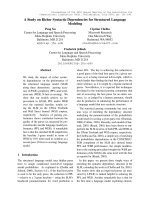

![gherghina et al - 2014 - a study on the relationship between cgr and company value - empirical evidence for s&p [cgs-iss]](https://media.store123doc.com/images/document/2015_01/02/medium_JKXoRwVO1T.jpg)
